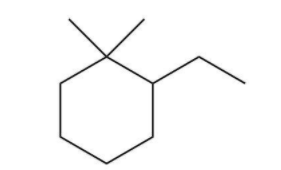
The IUPAC name of the following compound is:

${\rm{1,1 - Dimethyl - 2 - ethylcyclohexane}}$
${\rm{2,2 - Dimethyl - 2 - ethylcyclohexane}}$
${\rm{2 - Ethyl - 1,1 - dimethylcyclohexane}}$
${\rm{1 - Ethyl - 2,2 - dimethylcyclohexane}}$

Answer
565.8k+ views
Hint: We know that for naming any organic chemical compound, we need to know some basic rule of naming. Firstly, we know the rule about the functional group for identifying the parent chain.
Complete step by step answer
As we all know, for naming we need to know about the longest chain of the compound which is also named as parent chain. Then we need to identify all the substituents which are attached in the given organic compound chain. The prefix used for representing one atom is mono, for two atoms di, for three atoms tri respectively and so on. Generally, the carbon atoms which are attached to the functional group or side chains are always taken as first carbon, and the naming of the compound starts from the carbon only.
The numbering starts in the given compound is shown below.

So, in the given cyclic organic compound, the parent chain has six members. Hence, it is usually termed as cyclohexane. Then only one ethyl group and two methyl groups are present on the ring like the substituents. Usually, the names of those substituents are written in alphabetical order. The substituents follow the lowest sum of the rule. Thus, the IUPAC name of the given compound is ${\rm{2 - Ethyl - 1,1 - dimethylcyclohexane}}$.
Hence, the correct option for this question is C that is ${\rm{2 - Ethyl - 1,1 - dimethylcyclohexane}}$.
Note:
Organic chemistry is used for the synthesis of many other compounds. They are used as a laboratory reagent. IUPAC name is the name given to any compound by the method of IUPAC nomenclature. IUPAC nomenclature is the method of naming the chemical compounds on the basis of standards provided by the IUPAC i.e. International Union of Pure and Applied Chemistry.
Complete step by step answer
As we all know, for naming we need to know about the longest chain of the compound which is also named as parent chain. Then we need to identify all the substituents which are attached in the given organic compound chain. The prefix used for representing one atom is mono, for two atoms di, for three atoms tri respectively and so on. Generally, the carbon atoms which are attached to the functional group or side chains are always taken as first carbon, and the naming of the compound starts from the carbon only.
The numbering starts in the given compound is shown below.

So, in the given cyclic organic compound, the parent chain has six members. Hence, it is usually termed as cyclohexane. Then only one ethyl group and two methyl groups are present on the ring like the substituents. Usually, the names of those substituents are written in alphabetical order. The substituents follow the lowest sum of the rule. Thus, the IUPAC name of the given compound is ${\rm{2 - Ethyl - 1,1 - dimethylcyclohexane}}$.
Hence, the correct option for this question is C that is ${\rm{2 - Ethyl - 1,1 - dimethylcyclohexane}}$.
Note:
Organic chemistry is used for the synthesis of many other compounds. They are used as a laboratory reagent. IUPAC name is the name given to any compound by the method of IUPAC nomenclature. IUPAC nomenclature is the method of naming the chemical compounds on the basis of standards provided by the IUPAC i.e. International Union of Pure and Applied Chemistry.
Recently Updated Pages
Why are manures considered better than fertilizers class 11 biology CBSE

Find the coordinates of the midpoint of the line segment class 11 maths CBSE

Distinguish between static friction limiting friction class 11 physics CBSE

The Chairman of the constituent Assembly was A Jawaharlal class 11 social science CBSE

The first National Commission on Labour NCL submitted class 11 social science CBSE

Number of all subshell of n + l 7 is A 4 B 5 C 6 D class 11 chemistry CBSE

Trending doubts
Differentiate between an exothermic and an endothermic class 11 chemistry CBSE

10 examples of friction in our daily life

One Metric ton is equal to kg A 10000 B 1000 C 100 class 11 physics CBSE

Difference Between Prokaryotic Cells and Eukaryotic Cells

1 Quintal is equal to a 110 kg b 10 kg c 100kg d 1000 class 11 physics CBSE

State the laws of reflection of light




